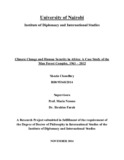| dc.description.abstract | Climate change has gained considerable degree of attention within the scholarly body of diplomacy and international studies. Analysts of the field argue that due to increased amount of GHG emissions, dynamic shifts are taking place in the global climate change. For instance, due to climate changes, the world has been facing rapid temperature rise, recurring droughts, desertification, heat waves, sea level rise, and flash floods. Consequently, with constrained availability of environmental resources, there are widespread negative impacts on human security, especially in the developing and underdeveloped regions. With other parts of the globe, Africa has been a key focus of discussions for the climate change community. The continent being home to the world’s most marginalised people is the greatest victim of climate change. Although, climate change is considered as a grave human security concern, the available literature fails to capture key issues. This study, therefore, analysed the likely inter-linkages between two variables; climate change and human security in Africa, employing the case study of the Mau Forest Complex. More specifically, the study provides an overview of the historical and contemporary analysis of the climate change debate; examined the conceptual and theoretical linkages between climate change, environmental scarcity, and human security in Africa and in the Mau Forest Complex and; analyse the causes, major impacts, and intersections between climate change and human security in Africa and in the Mau Forest Complex. Theoretical framework used in this study is Homer-Dixon’s environmental/renewable resource scarcity model. In relation to the study, this theory helped to trace out the interplay between climate change, scarcities of fundamental resources, and the consequent human security implications in Africa, as well as in the Mau Forest Complex. Primary data was compiled using semi-structured and unstructured interviews, focus group discussions, and records of researcher’s personal observations during the field trips. Quantitative data was sourced from Kenya Metrological Department. Secondary data relied on the internet and library research. Thematic analysis method was used to analyse key issues arising from the discussions. The major findings of the study include; (1) Human activities are the major determinants of climatic changes in Kenya’s Mau Forest Complex. (2) Climatic changes have notably led to resource scarcities with fundamental effects on various aspects of human security on the African continent, and in the Mau Forest Complex; (3) Climate change served as a key driver of human insecurity in Africa. The study recommends that while dealing with climate change and human security, global, regional, and national institutions, regimes, and policies be guided by taking consideration of the broader human insecurities. Study also recommends that future research be based on studying climate change led emerging threats to the security of vulnerable communities. Specifically, future research needs a key focus on identifying novel insecurities especially in relation to the developing and underdeveloped states, in particular from the broader perspectives of climate change governance and human security. Furthermore, research studies may look into issues regarding the ineffectiveness of the global, regional, and national climate change and security regimes and policies | en_US |

